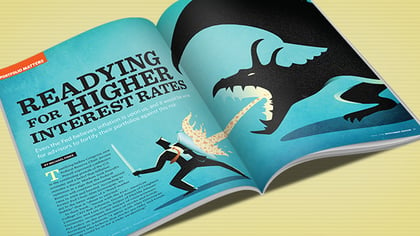Testifying before Congress, new Federal Reserve Chair Jerome Powell expressed confidence in the continuing growth of the U.S. economy and a belief that inflation remains a threat. Markets took Powell’s optimism as a sign that the Federal Reserve will continue increasing interest rates in 2018 and beyond. According to former Fed Chair Alan Greenspan, we are in the latter stages of a “bond market bubble” that is “about to unwind.”
In their book, “Invest with the Fed,” American College CEO Bob Johnson, Gerald Jensen of Creighton University and Luis Garcia-Feijoo of Florida Atlantic University, investigate the impact of contractionary Fed policy on the performance of stocks and bonds. According to Johnson, “I agree with Alan Greenspan. Investors who believe that stocks are risky and bonds are safe could be in for a rude awakening.”
Signaling rising rates had a predictable effect on markets. Bond yields rose, bond prices fell, and the stock market started showing some jitters that advisors and their clients haven’t seen in months. How should advisors prepare their clients for a new era of rising bond rates? What should they tell their clients to expect in 2018 and beyond?
Go Short Term
A common strategy is to protect clients from bond losses by reducing the duration of their bond portfolio. Duration is commonly used to estimate what will happen to the value of a bond portfolio if interest rates rise by 1% (say from 3% to 4%). The average long-term bond fund in the United States has a duration of 11 years according to Morningstar. If interest rates rise by 2%, the value of the bond portfolio will fall by about 22%.
This is a big risk in the portion of a portfolio that’s generally considered low risk. And a 2% rise doesn’t seem that implausible. Gail Gill, a financial planner at Worley Erhart-Graves Financial Advisors, is leaning toward a bond strategy that favors short-term bonds (which have a median duration of about 2 years).
“When I look at interest rates, I like to think in terms of extremes. From the early 1950s to the 1980s, it looks like a straight line up. After the 1980s, it’s a straight line down. I want to be the one riding the line up,” notes Gill.
A lot of advisors have been thinking that interest rates had nowhere to go but up for a long time. “Predicting the future interest rate environment for bonds is tough,” notes David Blanchett, head of Retirement Research at Morningstar.
Risks vs. Rewards
One widely used strategy has been to reduce the risk of an inevitable increase in interest rates by moving away from longer-term bond funds in recent years, but there is a significant cost to shielding clients from risk. “Worried about rising yields, many advisors have targeted lower durations for client portfolios for years, only to see yields stay relatively low,” notes Blanchett.
While it isn’t a bad idea to keep an eye out for what might happen, this type of positioning over the last decade has resulted in lower returns than could have been achieved if clients had accepted more interest rate risk to earn a term premium.
David Nanigian, associate professor of finance at Cal State Fullerton, agrees that advisors should be not only wary of timing the market, but also sensitive to the risk of rising rates. “I don’t think that advisors should try to predict the future levels of interest rates with great precision. Even economists who forecast interest rates for a living aren’t that good at it. I also don’t think that it is sustainable for interest rates to stay as low as they are. Therefore, I think that advisors should plan for a rising interest rate environment and craft portfolio management strategies accordingly.”
Blanchett agrees that “It makes sense to think about the current rate, but only as an adjustment to the typical target duration of the portfolio. For example, if it’s normally a seven-year target, maybe drop things to five years, but don’t go to all cash.”
This strategy resonates with Jay Barclay, a financial advisor at Strategic Financial Planning. “We stay intermediate-to-short knowing that rising interest rates will be a drag on the portfolio, but the primary objective is to maintain a diversified portfolio. It’s boring, but clients like boring.”
Focusing on risk is key. “Clients are not going to hit interest rate goals from the past,” cautions David Klaus, a financial planner at One to One Financial Advisors. “I stick with core intermediate bond funds. Short-terms funds have less risk, but there’s so little return there. I’m not big on long-term bond funds because of the risk.”
In other words, shorter-term bonds (which have historically underperformed intermediate-term bonds by 2% per year) will drag down a portfolio’s performance by missing out on the term premium. Longer-term bonds could drag down a portfolio’s performance by falling in value when interest rates rise.
What to Do?
It would seem advisors don’t have any good options. However, Harold Evensky, principal at Evensky-Katz/Foldes Wealth Management, notes that even “a paltry return will look very attractive in the event of a market correction.”
One option is to invest in an oft-forgotten hedge against inflation risk — the Treasury Inflation Protected Security, or TIPS. These government bonds, whose value rises with inflation, can be an overlooked way to achieve a term premium while also hedging against inflation risk. Gill notes that “For the first time in a long time, I’m considering using TIPS.”
While TIPS don’t provide protection against an increase in real (after inflation) interest rates, few economists see any indication that real rates will rise. Demographic or productivity trends suggest a steady demand for bonds. If investors are still looking for a safe way to set money aside for future spending, sellers won’t need to offer rates of return above the rate of inflation.









 March 30, 2018 at 01:05 PM
March 30, 2018 at 01:05 PM











